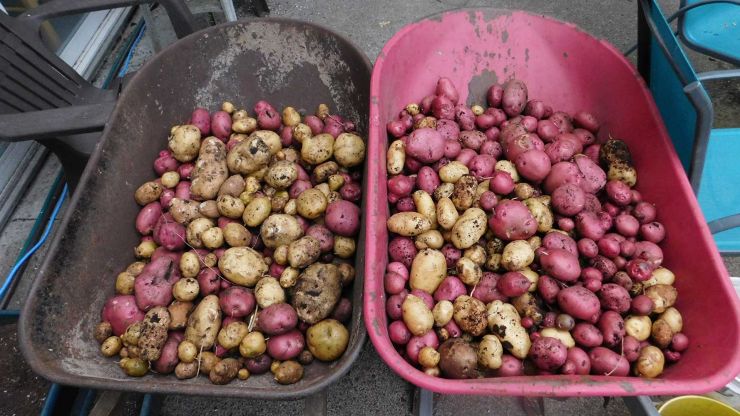

Growing and Harvesting Potatoes
Potatoes are one of the easiest vegetables to grow and so versatile in cooking. Who doesn't love mashed potatoes, fries, roasted potatoes? Is your mouth watering yet? Now imagine having a supply of organic potatoes just outside your front door to use for all your favourite recipes and the satisfaction of being able to say that you grew those potatoes yourself. Seed potatoes, which are a smaller version of what we eat, can be purchased at a local nursery or even online.
Where to Plant:
Potatoes can be grown in a large pot, raised bed, or directly in the ground. The best time to plant is right after the last spring frost. Potatoes should be grown in an area that gets full sun (at least 6 hours of sunlight per day) in soil that has good drainage. If your soil has a lot of clay you can add sand to increase the drainage. Potatoes will rot if they are left to grow in ground which has water pooling in it.
How to Plant:
If you choose to grow in a raised bed, or directly in the ground, you'll want to dig a trench first that is about 3-4 inches deep. Plant your seed potatoes 1 foot apart in rows that are 1 ½ - 2 feet apart. Potatoes grow under the soil with tall leafy green plants visible above the surface. When you see the potato plants reach a height of 12 inches, gather soil around the bottom of the plant, covering about half of its height. This is called “hilling”. Repeat “hilling” about every 2-3 weeks as each hill can produce another layer of potatoes. An alternative to hilling is to use straw or grass as a mulch around the potato plants. The advantage being that weeds are smothered and the soil stays moist. A disadvantage however, is that moisture may attract slugs, and mice and voles can use the straw as camouflage while they nibble on your potatoes.
Watering:
On average, potatoes need 1 inch of water per week. It is recommended to water the soil directly, avoiding the leaves, to a depth of 4-6 inches. When you see blossoms on the potato plant you can increase the amount to 1 ½ inches of water. Watering in the early morning is best to prevent evaporation in the heat of the day.
Harvesting:
If you like “new” or bite size potatoes, you can harvest them 7-8 weeks after planting. However, if you would like to have large potatoes then wait to harvest until about two weeks after the foliage turns yellow and begins to die. Use a shovel or trowel to carefully dig around the plant and unearth the potatoes. After digging up the potatoes, brush off the dirt and store them in a cool dry place, without washing, for three days to cure. Wash the potatoes just before cooking. This process will allows the potatoes to last longer, and even be stored for future months.
Storing Potatoes:
If you have an excess crop of potatoes you can keep some for the next year to plant instead of buying seed potatoes. In order to do this you will need to store your potatoes in a cool dark place, where the temperature is 4-7 degrees celsius. Storing them in a cardboard box or paper bag in the garage is recommended. Make sure to check them often and remove any that are soft, to prevent mold from forming.
Companion Planting:
There are certain plants that grow well together and this is called companion planting. Potatoes pair well with cilantro, oregano, bush beans and carrots planted in the space between the potato plants.
Ramona Stevens
